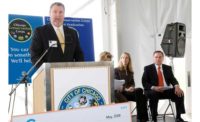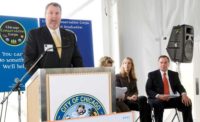Robert P. Madison fought in World War II in Italy as a proud member of the historic Buffalo Soldiers, the all-African-American unit of the U.S. Army that traces its lineage back to the Civil War. Second Lieutenant Madison was wounded in combat and received a purple heart, but when he returned to civilian life in 1946, eager to resume his education at Western Reserve University (now Case Western Reserve) in Cleveland, his application was summarily denied simply because he was black.
A few days later, Madison returned in his full dress uniform with his purple heart and, shamed and under duress, administrators grudgingly admitted him to the university even though some whispered, “you will never be an architect.”
It was one of the many times that Madison, now 96, was underestimated during a life that created social change—Madison became the first African-American architect in Ohio, only the 10th in the nation, and eventually was named president of the Cleveland chapter of the American Institute of Architects.
Madison’s career includes numerous milestones, such as working on some of the most important buildings in Cleveland, founding Robert P Madison International (RPMI), which continues to thrive today, and opening the door for minority architects across both business and academia.
“I came along at a time when things were pretty rough, as you could call it,” Madison says. “My mother was the real anchor in our whole life, and my father was trying to get a job in and out. I think that my mother was the one who said, ‘Look, you’re going to have to be twice as good as anybody else,’ and she meant that.”
Madison, a native of Cleveland, was growing up in Washington, D.C., during the Great Depression when he gleaned a formative lesson from his mother.
“We had some pretty difficult times, and I remember we were evicted,” he says. “I went to school in the morning and came back, and all the furniture that we had, all of our belongings, were on the sidewalk. The rain was coming down and it was terrible, but my mother said, ‘The Lord is testing you. He wants you to be strong. This is just a test. You’ll be okay.’ You know what? We believed that.”
After moving back to Cleveland and going to East Technical High School, Madison embraced his strengths. And he excelled in mathematics.
When Madison tied with another student for a math prize at commencement, the school held a tie-breaker exam on a Saturday.
“We both took the exam for an hour and a half, and we laughed and we found out that they said it was still a tie. As far as I’m concerned, I think they just didn’t want to give it to me,” Madison says. “That was my realization that you got to be twice as good as anybody else to get equal.”
It would be one of many tests Madison would pass over the course of his career. Madison always wanted to be an architect going back to his earliest youth, even studying how building orientation made the home of his grandmother in Alabama comfortable in the heat despite it not having running water or electricity.
“The amazing thing to me is this all started—try and picture this—in 1928, and a five-year old black child in southern Alabama is told by his mother, after looking at one his school drawings, that he will be architect. And Robert answered, ‘Yes, Mother,’” says Robert Klann, CFO of RPMI.
“Aspire to be great because you can do it no matter who says you can’t.”
– Robert P. Madison
Madison studied architecture at Howard University, but his education was interrupted by World War II. After the war, he graduated from Western Reserve and got his master’s degree in architecture from Harvard, studying under Walter Gropius. He was granted a Fulbright Fellowship in Architecture and Urban Design to study at the L’Ecole des Beaux Arts in Paris, where he received instruction from Le Corbusier and Eugene Freyssinet.
In 1954, after teaching architecture at Howard University for a year, Madison decided to return to Cleveland. He sought to start his own company, reasoning that the only way to effect the social change he wanted to see was to open an African-American-owned architecture firm to employ people of color.
“Why are we teaching these students architecture, but when they graduate there’s no real place for them to work? And they don’t know anybody in their field? I made it my mission to create a business of my own,” Madison says.
After he left Howard, he worked briefly for the firm of Cleveland-based architect Robert A. Little, originally for free just to get work to get registered in Ohio. When he took the state board examination, he passed the first time. Madison then went on to open the firm that would become RPMI in 1954.
RPMI would become either architect or architect of record for numerous major Cleveland projects, including the Quicken Loans Arena, the Rock and Roll Hall of Fame (where Madison collaborated with his late friend I.M. Pei), Cleveland Browns Stadium, the Frank Lausche State Office Building and the Carl B. Stokes U.S. Courthouse. Outside of Cleveland, the firm delivered many African Methodist Episcopal churches and international commissions, such as the U.S. Embassy in Dakar, Senegal.
“I was simply trying to understand human behavior, that’s my architecture,” Madison says. “Develop a sense of how the design assisted the people, and when they’re happy, I’m happy. We also did a lot of housing for elderly people and low income families, and, boy, what a pleasure it is to see people who never had a chance to even come close to a brand new building live in it for a while and appreciate what it’s like for everything to work as it should.”
Over the years, RPMI’s business grew and Madison was able to hire hundreds of African-American architects and engineers, and the firm became one of the most well-known prestressed concrete designers in the region. Madison was invited to be on the board of trustees at Case Western Reserve University. He was also a key supporter in the election of Carl Stokes in 1967, who was Cleveland’s first African-American mayor. Upon his retirement in 2016, Madison sold the firm to his nephew Kevin Madison and his wife, Sandra Madison, and Klann.
“If there’s one thing I’d like to see change, is we had very few employees who wanted to go on to get graduate degrees and really go to the very top,” Madison says. “Aspire to be great because you can do it no matter who says you can’t. That’s the advice I’d give young people today.”
If you’d like to learn more about the legacy of Robert P. Madison, read his memoir “Designing Victory,” from Act 3 Creative.













Post a comment to this article
Report Abusive Comment